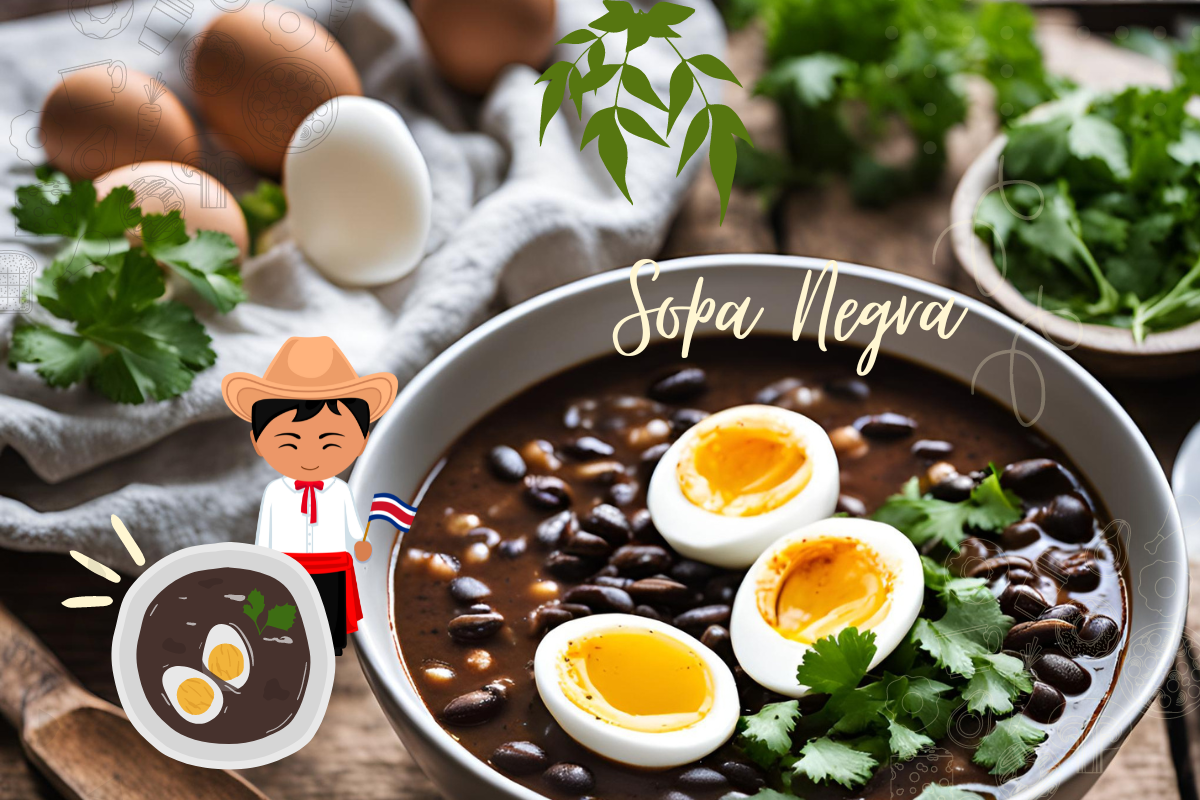Sopa Negra: Costa Rica’s Comfort Food
Planning your trip to Costa Rica and unsure about what to eat? No need to stress! This article will introduce you to Sopa Negra, a cherished Costa Rican speciality that will surely delight your palate.
Sopa Negra or black bean soup, is more than just a meal; it’s a celebration of Costa Rican flavours and traditions. This hearty and flavorful soup highlights the country’s agricultural bounty and cultural heritage, blending simple ingredients into a delicious experience.
From its rich history to its comforting taste, Sopa Negra offers a unique glimpse into Costa Rican cuisine.
This article explores the delicious Sopa Negra, how it is prepared, its nutritional benefits, local twists, beverages to enjoy and restaurants that serve Sopa Negra. Let’s dive in and enjoy the vibrant flavours of Sopa Negra!
What is Sopa Negra?
- Costa Rica is known for its rich wildlife and beautiful scenery and also has a strong food tradition. One of its most important dishes is Sopa Negra or black bean soup.
- This flavorful soup is a big part of Costa Rican culture and represents the country’s farming roots, the creativity of its people, and the comfort of homemade meals.
- Sopa Negra has deep roots in Costa Rica’s history as it is a country known for its farming. Black beans have been a key part of the Costa Rican diet for a long time because they are nutritious, cheap, and easy to grow.
- When Europeans arrived in Central America, they mixed their cooking with local food traditions. This blend of ingredients and techniques helped create new dishes, including Sopa Negra.
- Soon, this simple bean soup became a beloved part of Costa Rican cuisine, known for its rich taste and tradition.
- Sopa Negra is very important in Costa Rican culture and is often served at family gatherings and celebrations. Making this soup is a cherished tradition that’s passed down through generations.
Preparing The Perfect Sopa Negra
Key Ingredients
The beauty of Sopa Negra is its simplicity, with the help of just a few key ingredients, you can create a flavorful and nutritious dish. Here are the main ingredients of Sopa Negra:
i. Black Beans: Black beans are the star of the dish. They are rich in protein, fibre, and essential vitamins and minerals. They are typically soaked overnight and then cooked until tender.
ii. Onions: Adding onions brings a subtle sweetness and depth to the soup.
iii. Garlic: Garlic for its aromatic and medicinal properties and is a crucial component. It provides a robust flavour.
iv. Cilantro: Fresh cilantro adds a fresh, herbal flavour to the soup, helping to balance the rich taste of the beans.
v. Bell Peppers: These contribute a slight sweetness and vibrant colour.
vi. Hard-Boiled Eggs: A traditional addition, hard-boiled eggs add texture and richness to the soup.
vii. Sour Cream: Often served on the side, sour cream adds a tangy contrast to the savoury soup.
viii. Chili Peppers (optional): For those who enjoy a bit of heat, chilli peppers can be added to spice up the dish.
How To Prepare Sopa Negra
| Prep Time 15 minutes | Cook Time 1 Hour 45 Minutes | Total Time 2 Hours | Serves 4-6 People |
Making Sopa Negra is simple, but it takes some time to let the flavours blend well. Here’s a basic guide to preparing authentic Costa Rican Sopa Negra:
1. Cook the Beans (if using dried beans)
– Rinse the dried black beans under cold water.
– In a large pot, add the beans and 8 cups of water. Bring to a boil, then reduce the heat and let the beans simmer for about 1.5 to 2 hours until they are tender. Drain and set aside.
2. Sauté the Vegetables
– In a large pot, heat the vegetable oil over medium heat.
– Add the chopped onion, minced garlic, and red bell pepper. Sauté until the onions are translucent and the peppers are soft about 5-7 minutes.
3. Combine Ingredients
– Add the cooked black beans (or canned beans if using) to the pot with the sautéed vegetables.
– Stir in the cumin, bay leaf, and half of the chopped cilantro.
– Add enough water to cover the beans and bring to a boil.
– Reduce the heat to low and let the soup simmer for about 20 minutes, allowing the flavours to meld together.
4. Season the Soup
– Remove the bay leaf and season the soup with salt and pepper to taste.
– For a smoother texture, you can use an immersion blender to puree some of the soup while leaving some beans whole, or you can blend a portion of the soup in a blender and return it to the pot.
5. Serve
– Ladle the Sopa Negra into bowls.
– Place a halved hard-boiled egg in each bowl.
– Garnish with the remaining fresh cilantro and, if desired, add a dollop of sour cream and a squeeze of lime juice.
6. Optional
– Serve with a side of crusty bread, rice, or tortillas for a complete meal.
Nutritional Benefits Of Sopa Negra
Sopa Negra is not only delicious but also highly nutritious. The primary ingredient, black beans, is a powerhouse of nutrients, offering a range of health benefits:
i. Protein: Black beans are an excellent source of plant-based protein, making Sopa Negra a satisfying and filling meal.
ii. Fiber: High in dietary fibre, black beans help support digestive health and regulate blood sugar levels.
iii. Vitamins and Minerals: Black beans are rich in essential vitamins and minerals, including folate, iron, magnesium, and potassium, which contribute to overall health and well-being.
iv. Antioxidants: Black beans are packed with antioxidants, which help protect the body against oxidative stress and reduce the risk of chronic diseases.
The addition of other ingredients, such as onions, garlic, and cilantro, further enhances the nutritional profile of the soup, providing vitamins A, C, and K, as well as anti-inflammatory properties.
Local Twists on Sopa Negra
While Sopa Negra is popular all over Costa Rica, different regions have their own versions of the dish, each adding a unique twist to the traditional recipe.
Caribbean Coast
On Costa Rica’s Caribbean coast, where Afro-Caribbean culture is vibrant, Sopa Negra is often made with coconut milk, making it rich and creamy with a hint of sweetness. Some people also add spicy Scotch bonnet peppers for an extra kick of heat.
Central Valley
In the Central Valley, where Costa Rica’s capital, San José, is located, cooks typically make Sopa Negra in a simple way to let the natural flavour of the beans stand out.
It features a milder flavour with less spice and often accompanies gallo pinto (a traditional rice and bean dish) or crusty bread on the side.
Northern Region
In northern Costa Rica, Sopa Negra is often served with plantains or yuca, which adds a starchy and slightly sweet flavour to the soup.
Vegetarian and Vegan Adaptations
With the growing popularity of plant-based diets, Sopa Negra has been adapted for vegetarians and vegans. The traditional recipe is already vegetarian, but modern versions skip the egg and sour cream to make it fully vegan.
How to Enjoy Sopa Negra Beyond the Traditional Recipe
If you are someone who loves Sopa Negra but wants to explore beyond the traditional recipe, there are numerous ways to enjoy this dish with a creative twist. Here are a few ideas you can experiment with:
1. Sopa Negra with a Twist of Citrus
You can add a bit of fresh lime juice or orange zest to enhance the flavours of Sopa Negra. Citrus adds a refreshing touch that complements the beans’ rich taste, making it ideal for warm weather. You can also add lime wedges as a garnish for extra tanginess.
2. Sopa Negra with Avocado
You can add avocado to Sopa Negra to make it creamier and add a mild flavour that balances the soup’s richness. You can either dice it and use it as a topping or blend it into the soup for a smoother texture, giving a fresh twist to this classic dish.
3. Spicy Sopa Negra
For those who enjoy spicy food, enhancing Sopa Negra with various peppers can bring a new dimension of flavour. Consider using habanero, jalapeño, or even chipotle peppers to introduce smokiness and heat. Pairing the soup with a cooling element, like a dollop of yoghurt or crema, can help balance the spice.
4. Sopa Negra with Roasted Vegetables
You can also add roasted vegetables like sweet potatoes, carrots, or squash to introduce a depth of flavour and a slightly sweet undertone. Roasting the vegetables caramelizes their natural sugars, which contrasts beautifully with the savoury beans.
5. Sopa Negra with Cornbread Croutons
Instead of the traditional bread or tortilla, try making cornbread croutons to accompany your Sopa Negra. The slightly sweet, crumbly texture of cornbread adds an interesting contrast to the soup. Simply bake cornbread, cut it into cubes, and toast them until crisp.
6. Sopa Negra with Meat or Seafood
For a heartier version, you can add shredded chicken, pork, or even seafood like shrimp. This addition turns Sopa Negra into a complete meal, particularly appealing to those who prefer a protein boost in their soups. The meat or seafood can be cooked in the soup or grilled separately and added just before serving.
7. Sopa Negra with Cheese
Adding cheese to Sopa Negra can make it richer and creamier. A spoonful of soft cheese like queso fresco or a sprinkle of sharp cheddar melts into the soup, enhancing its flavour. For an extra treat, try serving it with cheese-stuffed bread on the side.
8. Sopa Negra Tostadas
You can also turn Sopa Negra into a topping for crispy tostadas by first thickening the soup a bit. Spread the thickened soup on tostadas and add fresh toppings like chopped tomatoes, avocado, and cheese for a tasty appetizer or light meal.
Pairing Sopa Negra with Beverages
Pairing Sopa Negra with the right drink can make the meal even better by complementing its flavours. Here are some drink options that go well with Sopa Negra:
1. Traditional Costa Rican Beverages
– Agua Dulce: This traditional Costa Rican drink is made from unrefined cane sugar dissolved in hot water and offers a sweet and comforting contrast to the savoury soup.
– Frescos (Fruit Beverages): Costa Rica is known for its abundance of tropical fruits, and frescos made from fresh fruits like tamarind, passion fruit, or guava provide a refreshing counterpoint to the heartiness of Sopa Negra.
2. International Beverage Pairings
– White Wine: A crisp, dry white wine, such as a Sauvignon Blanc is the best way to balance the richness of the beans while enhancing the fresh notes from the cilantro.
– Beer: A light, refreshing beer, like a Pilsner or a Pale Ale is another refreshing way to cleanse the palate and pair well with the earthy flavours of the beans. If you are someone who enjoys a bit more body in their beer, a darker beer can complement the depth of the soup.
3. Non-Alcoholic Options
– Iced Tea: A cold, unsweetened iced tea can be a refreshing accompaniment to Sopa Negra, particularly in warmer climates. The tea’s subtle bitterness balances the savoury soup.
– Herbal Infusions: Infusions made from herbs like mint or lemongrass provide a light, aromatic contrast to the robust flavours of the soup.
Meal Planning with Sopa Negra
Sopa Negra can easily be a regular part of your meals because it’s versatile, easy to make, and healthy. Here’s how you can include Sopa Negra in your weekly meal plan:
1. Batch Cooking
You can prepare a large batch of Sopa Negra at the start of the week to save time and provide ready-made meals.
The soup stores well in the refrigerator for several days, and its flavours often improve with time as they meld together. Simply reheat portions as needed for a quick, nutritious lunch or dinner.
2. Freezing for Later
Sopa Negra also freezes well which makes it an excellent option for meal prep. Divide the soup into individual portions and freeze them for up to three months. Thaw and reheat for a comforting meal whenever you need it.
3. Serving Suggestions
– Lunch: You can pair Sopa Negra with a simple salad and crusty bread for a balanced and satisfying lunch.
– Dinner: Serve Sopa Negra as a starter, followed by a light main course, such as grilled fish or roasted vegetables.
– Brunch: For a hearty brunch, you can serve Sopa Negra with eggs cooked to your preference and a side of fried plantains.
Restaurants Serving Sopa Negra
| Restaurants | City | Cuisine |
| Restaurante La Esquina de Buenos Aires | San José | Argentine and Local |
| Soda Tapia | San José | Costa Rican |
| La Criollita | San José | Costa Rican |
| Restaurante Grano de Oro | San José | Costa Rican |
| Soda El Kiosco | Liberia | Costa Rican |
| El Jardin de Lolita | San José | Costa Rican |
| Soda La Chispa | San José | Costa Rican |
| Soda La Terraza | San José | Costa Rican |
| El Reloj de Tico | San José | Costa Rican |
| Soda El Poblado | Cartago | Costa Rican and Central American |
| Soda Viquez | San José | Costa Rican |
| La Parada de Tacos | San José | Mexican and Local |
Wrap Up
Sopa Negra is a cherished dish in Costa Rica, reflecting the country’s rich farming heritage, cultural traditions, and focus on sustainability. Originally a simple bean soup, it has grown into a popular dish found even in gourmet restaurants, yet it remains true to its roots.
Its versatility, health benefits, and cultural importance make Sopa Negra a dish to celebrate, whether you’re enjoying it in Costa Rica, abroad, or at home.
Whether you’re a seasoned chef or a home cook, Sopa Negra invites you to experience the warmth and comfort of Costa Rican cuisine, one bowl at a time.
FAQs
1. What is Sopa Negra made of?
- Sopa Negra features black beans, onions, garlic, cilantro, bell peppers, and hard-boiled eggs. Often, people serve it with sour cream and occasionally add chilli peppers for extra spice.
2. What is sopa de lima made of?
- Sopa de Lima combines chicken or turkey broth, lime juice, shredded chicken or turkey, tomatoes, onions, garlic, bell peppers or chiles, and cilantro. People garnish it with crispy tortilla strips.
3. What is Sopa made of?
- Sopa generally refers to a soup in Spanish cuisine and can vary widely, but it often includes a broth (chicken, beef, or vegetable), vegetables, noodles or rice, and sometimes meat or beans. The type of sopa being made determines the specific ingredients.







